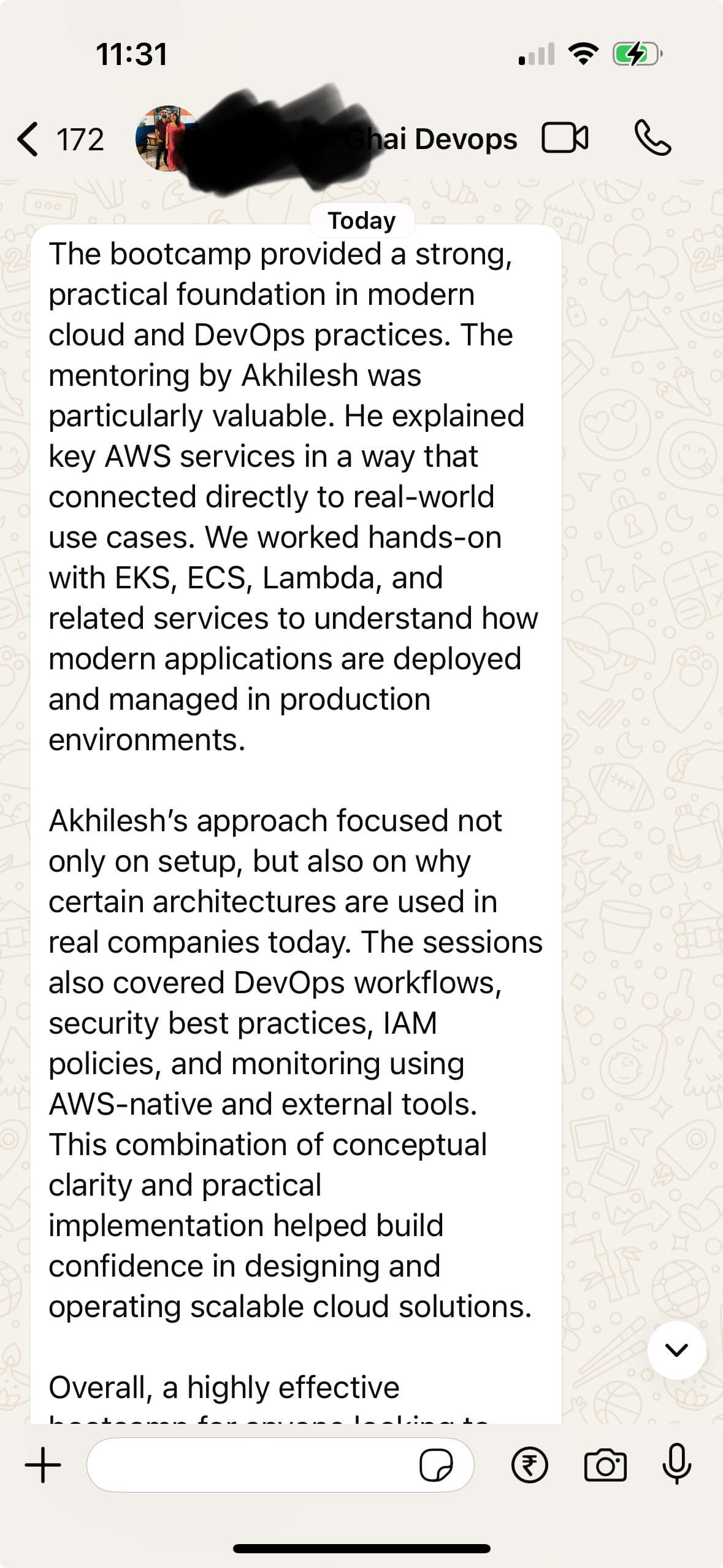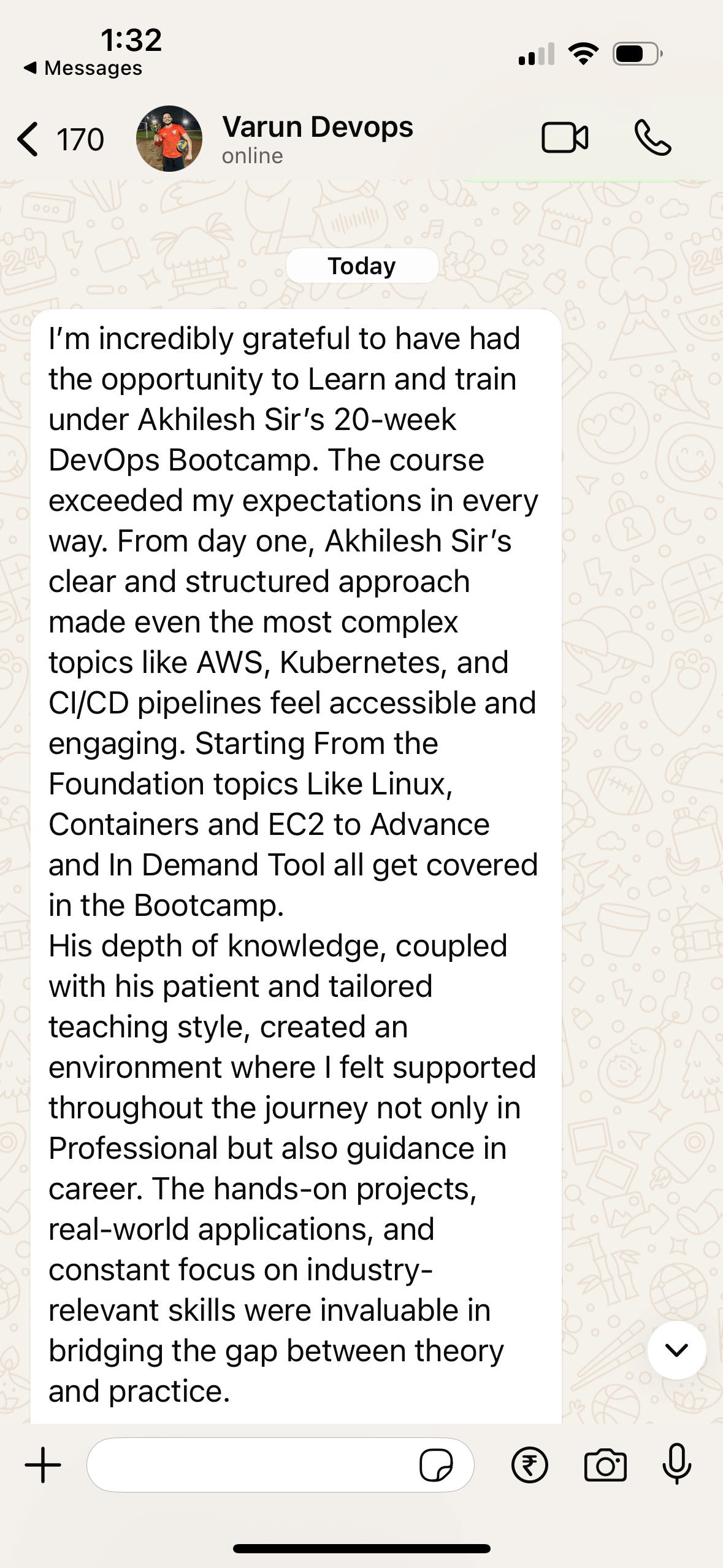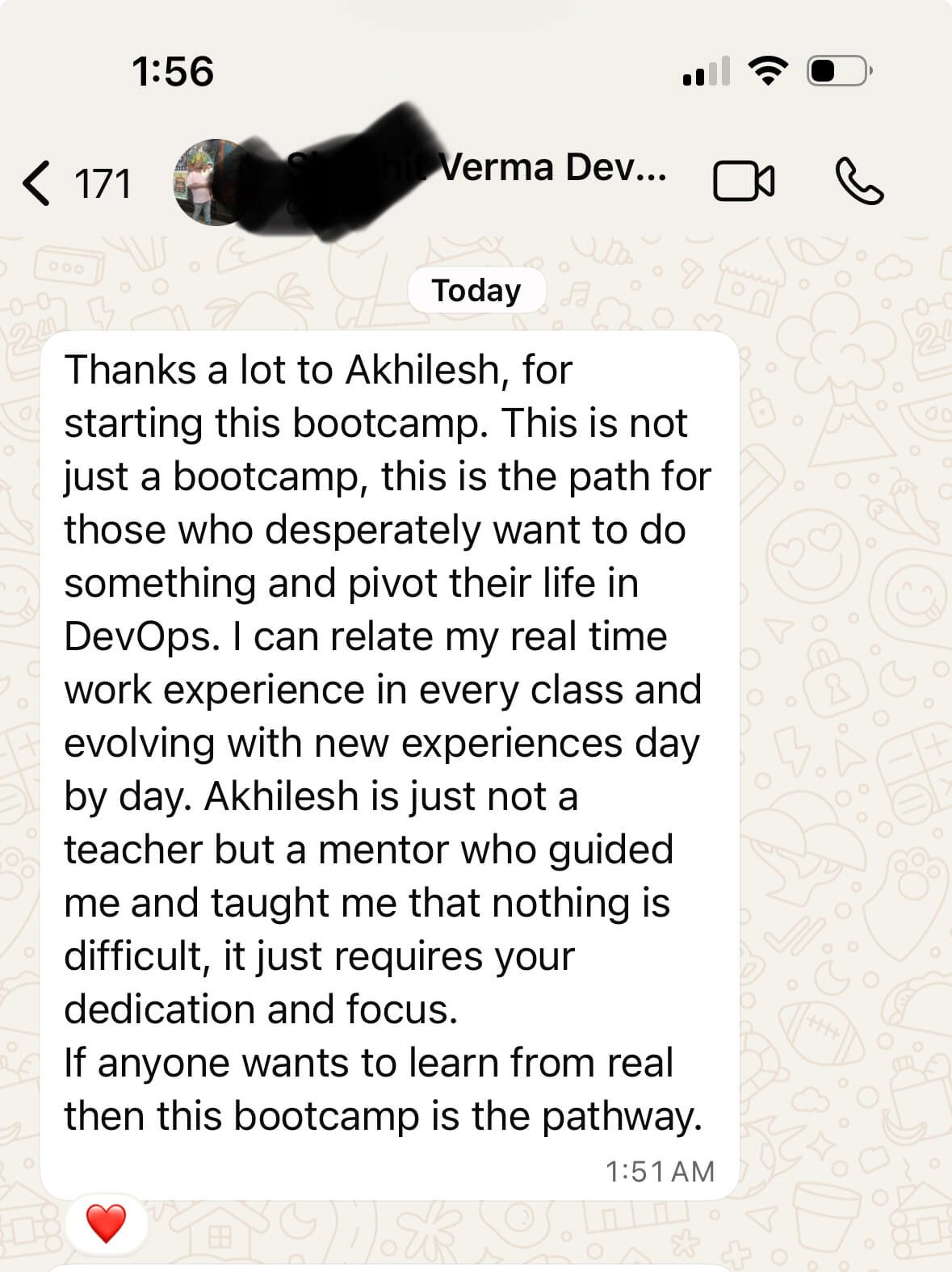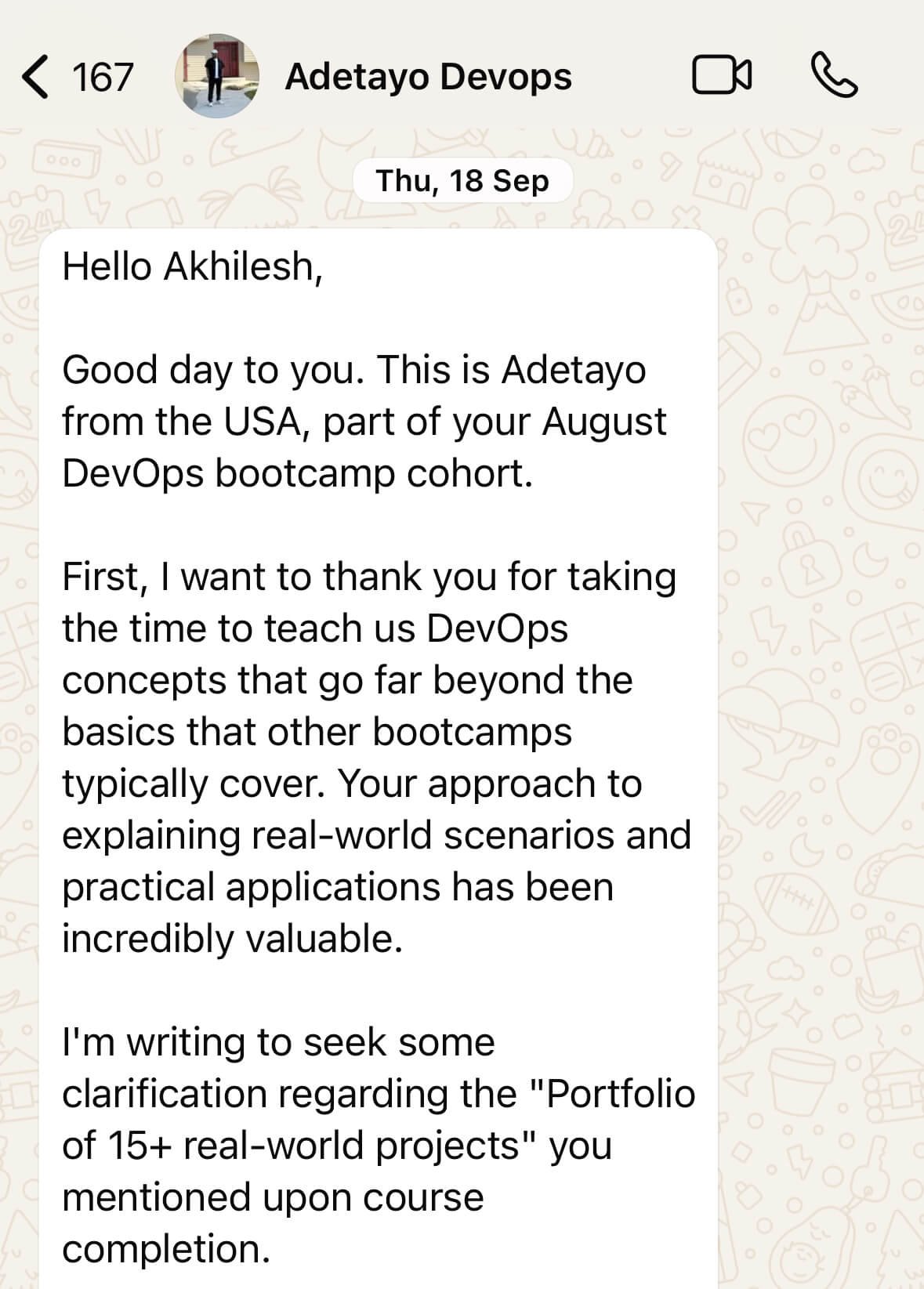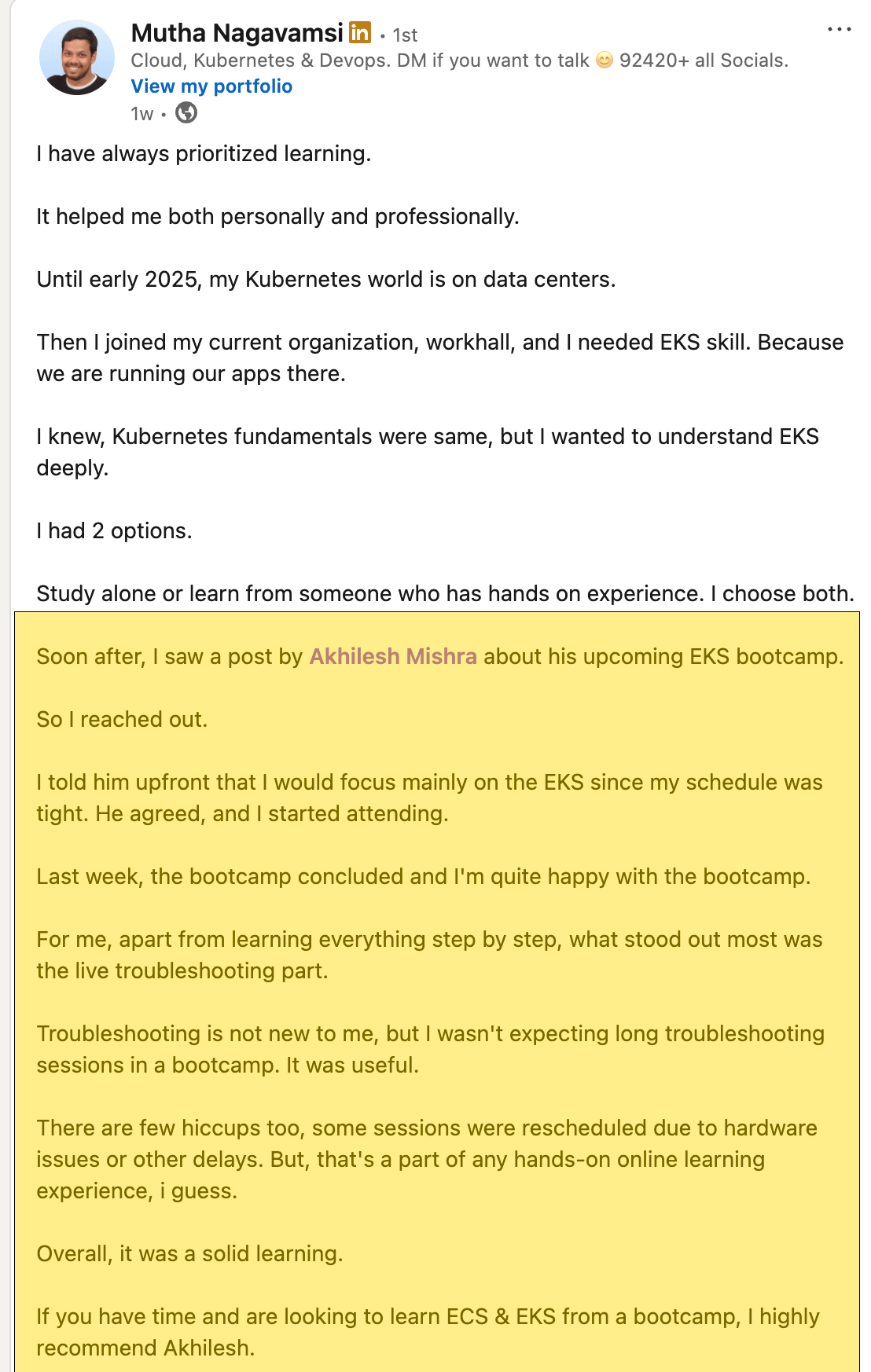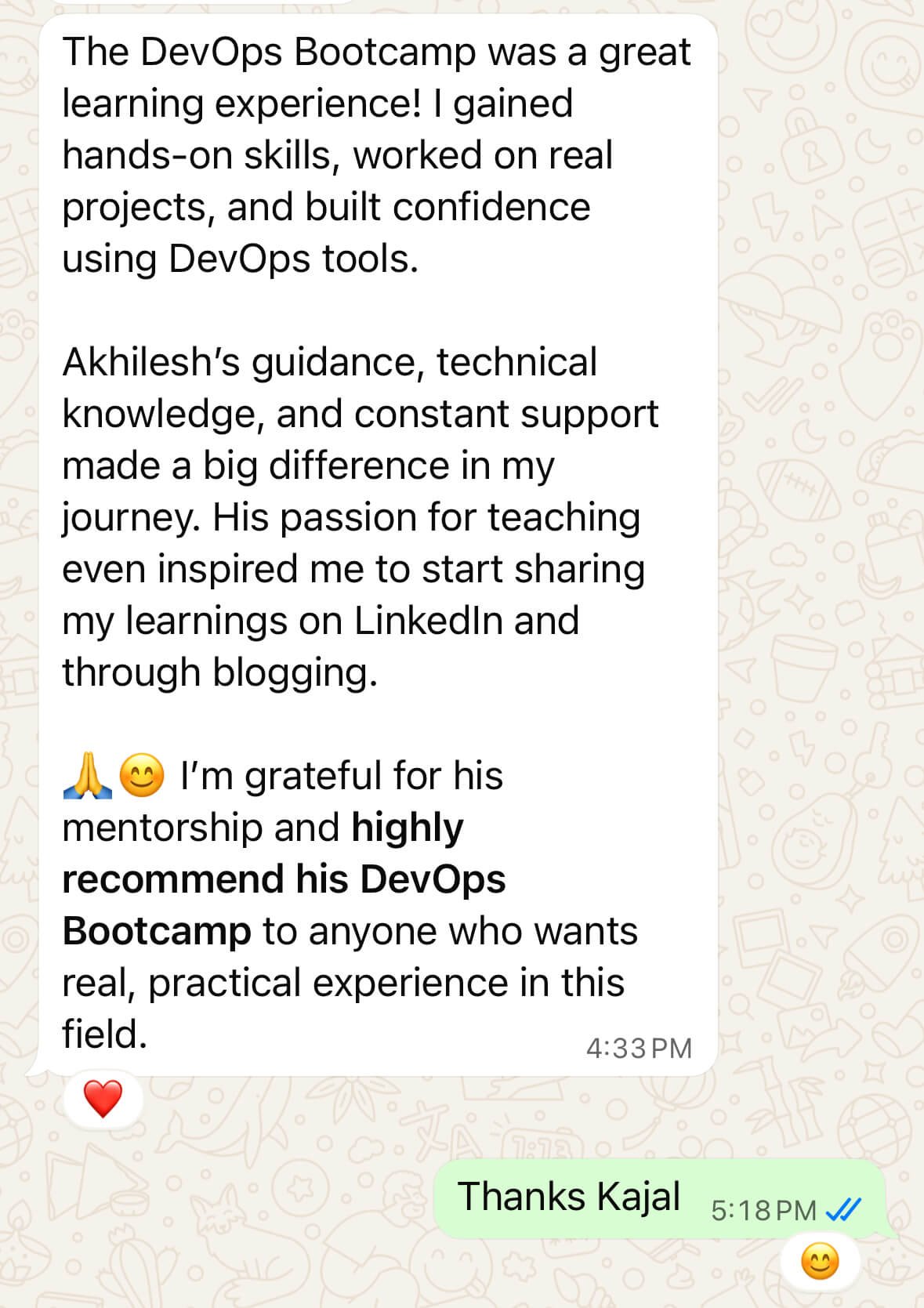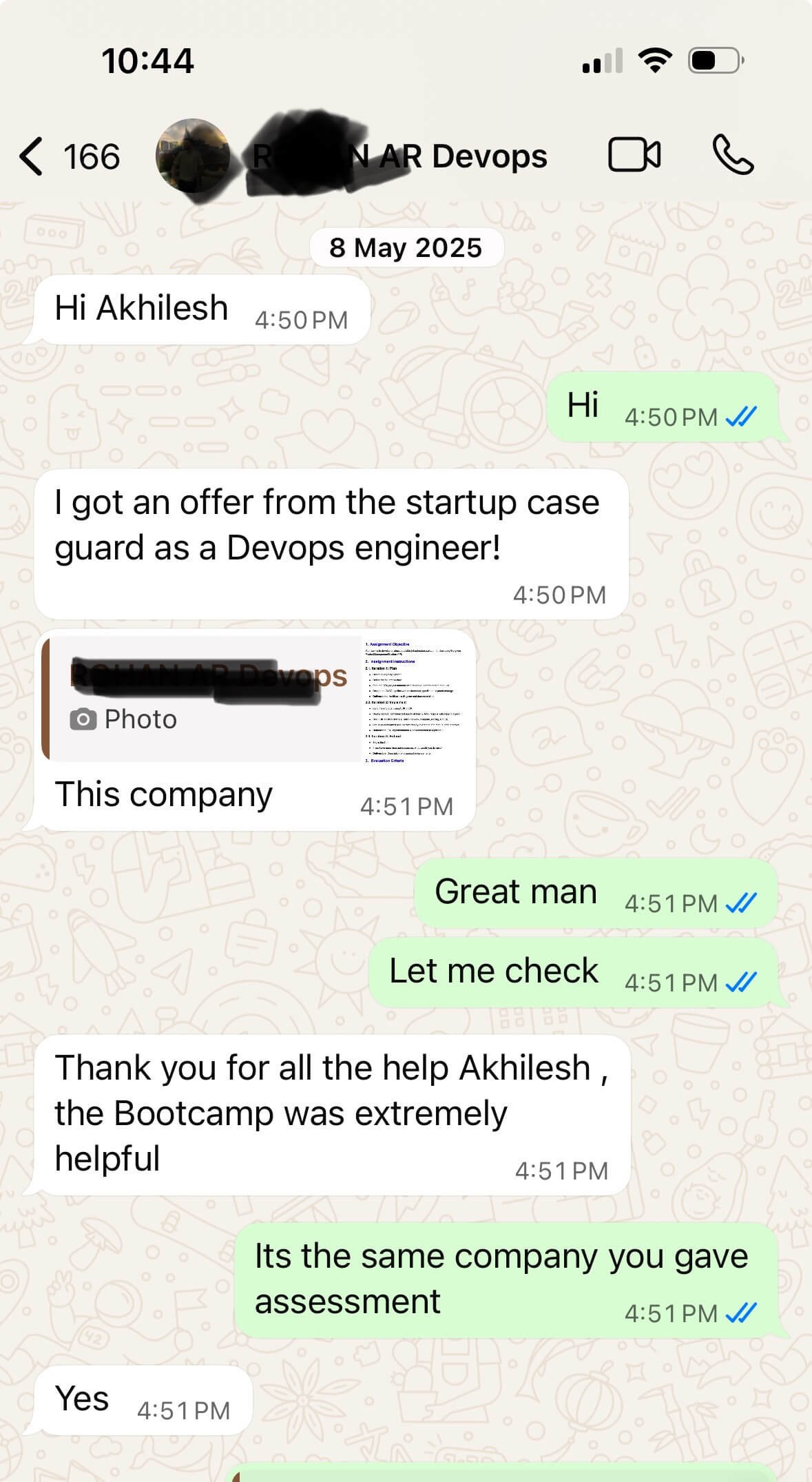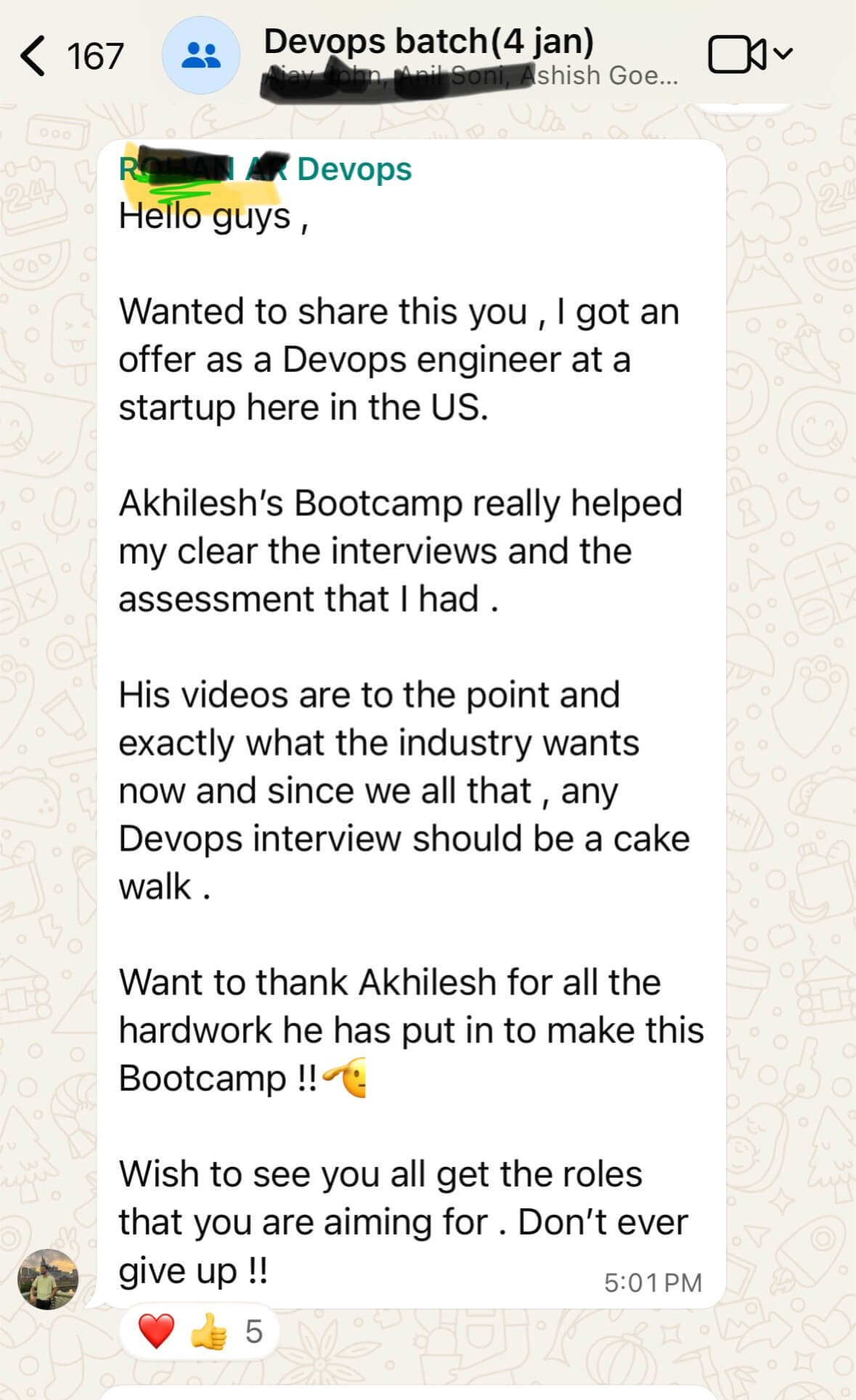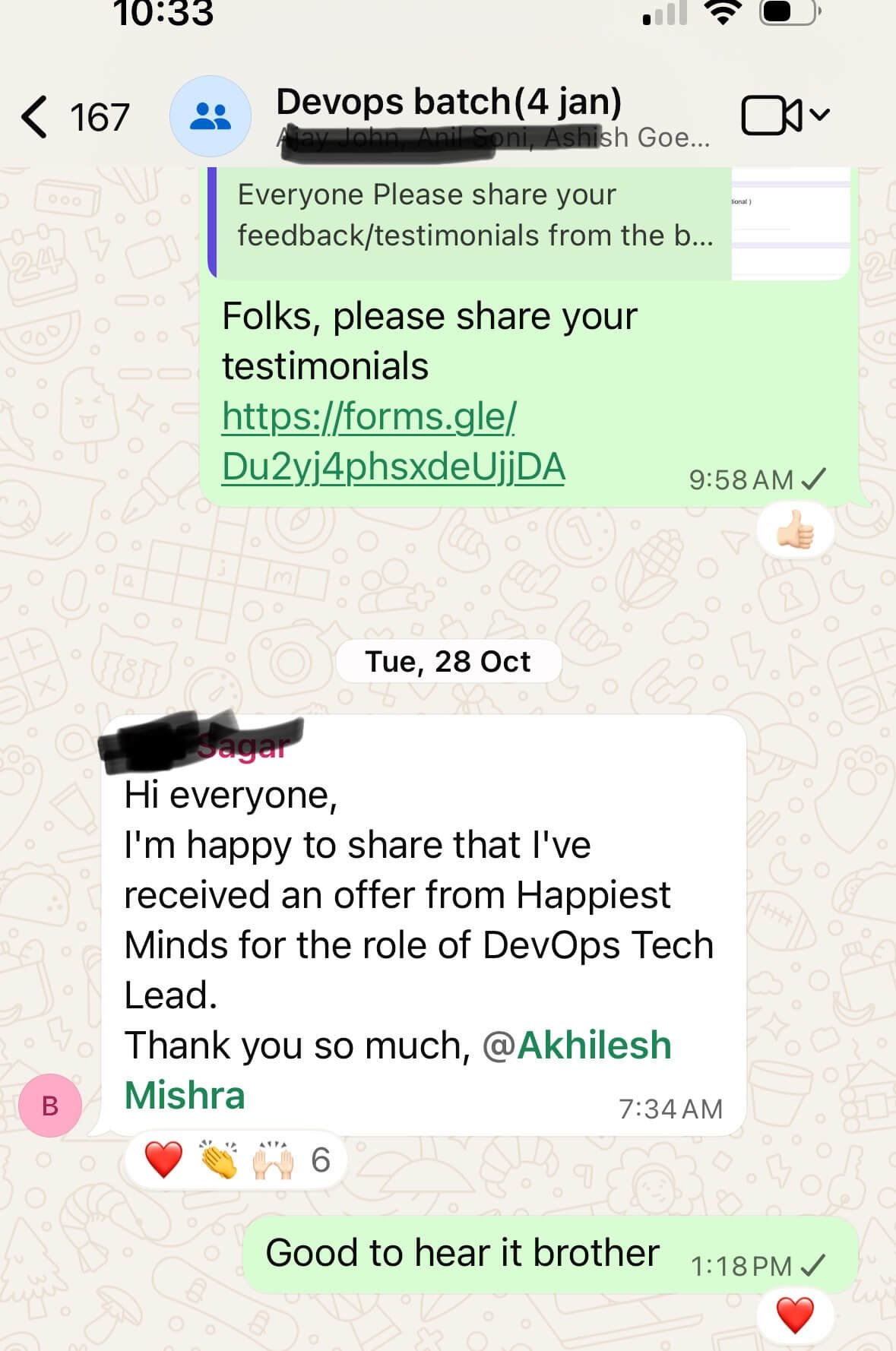Learn DevOps with Advanced, real-world projects, live troubleshooting
Advanced K8s (EKS) Bootcamp
Demo Classes
Bootcamp Details
- Fee: ₹20K ($225)
- Total Classes: 15
- Duration: 150 minute
- Format: Live Classes
- Starting On: 2025-12-06
- Classes on: Saturday & Sunday
- Timings: 10.00 AM - 12.30 PM IST
- Language: English
Kubernetes and Container Orchestration Bootcamp – 15 Classes
Duration: 15 sessions, 2.5 hours each, Live classes
Note:
- All classes will be live classes, and they will also be recorded
- The recording will be shared along with notes, assignments, resources, and other relevant materials. Lifetime access to recordings.
- Group Chat on WhatsApp and Discord for all communications, discussions, and troubleshooting during bootcamp
This comprehensive Kubernetes bootcamp takes you from fundamentals to production-grade EKS deployments with advanced security, observability, and GitOps practices. You’ll learn to architect, deploy, and manage containerized applications at scale using industry best practices and real-world patterns.
Pre-requisites:
- Basic AWS knowledge (EC2, VPC, IAM, S3)
- Terraform fundamentals (resources, modules, state management)
- GitHub Actions basics (workflows, jobs, steps)
- Docker fundamentals
- Basic Linux command line
- Understanding of YAML
What’s Included:
- All 15 class recordings (lifetime access)
- Complete Terraform modules and configurations
- Production-ready Helm charts
- GitHub Actions workflow templates
- Hands-on project code and documentation
Class 1: Kubernetes Architecture & Core Concepts
What you’ll learn:
- Kubernetes architecture: control plane, worker nodes, etcd
- Core resources: Pods, Services, Deployments, ReplicaSets
- ConfigMaps and Secrets for configuration management
- Namespaces for resource organization and isolation
- kubectl commands and cluster interaction patterns
- Local Kubernetes development with Minikube/Kind
Hands-on:
- Set up local Kubernetes environment
- Deploy multi-tier application (frontend, backend, database)
- Expose services using ClusterIP, NodePort, LoadBalancer
- Manage application configuration with ConfigMaps
- Handle sensitive data with Kubernetes Secrets
- Perform rolling updates and rollbacks
Project: Multi-Tier Application Deployment Deploy a complete application stack:
- React frontend service
- Flask/Node.js backend API
- PostgreSQL database
- Configure service-to-service communication
- Implement health checks and readiness probes
- Execute rolling updates with zero downtime
Class 2: Advanced Kubernetes Workloads & Storage
What you’ll learn:
- StatefulSets for stateful applications with stable identities
- DaemonSets for node-level services (monitoring, logging)
- Jobs and CronJobs for batch processing and scheduled tasks
- Persistent Volumes (PV) and Persistent Volume Claims (PVC)
- Storage Classes and dynamic volume provisioning
- Volume snapshots and backup strategies
- Init containers and sidecar patterns
- Pod disruption budgets for high availability
Hands-on:
- Deploy StatefulSet with ordered pod management
- Configure persistent storage for databases
- Implement DaemonSets for log collectors
- Create CronJobs for database backups
- Set up volume snapshots
- Configure pod disruption budgets
Project: Stateful Application with Proper Storage Implement:
- StatefulSet for Redis cluster with persistence
- PostgreSQL with persistent volumes
- Automated backup CronJob
- Volume snapshot and restore procedures
- Pod disruption budgets for reliability
Class 3: Kubernetes Networking & Security Fundamentals
What you’ll learn:
- Kubernetes networking model and CNI plugins
- Service types: ClusterIP, NodePort, LoadBalancer, ExternalName
- Network policies for pod-level traffic control
- Ingress resources and ingress controllers
- Security contexts and pod security standards
- Resource requests, limits, and Quality of Service (QoS)
- RBAC (Role-Based Access Control) fundamentals
- Service accounts and workload identity
Hands-on:
- Implement network policies for microservices isolation
- Configure security contexts for least privilege
- Set resource quotas and limit ranges per namespace
- Create RBAC roles and role bindings
- Deploy NGINX Ingress Controller
- Configure ingress rules for routing
Project: Secure Multi-Tenant Application Build:
- Network policies for database isolation
- RBAC configuration for team access
- Resource quotas per environment
- Security contexts for all workloads
- Ingress routing with path-based rules
Class 4: Terraform for EKS – Infrastructure Setup
What you’ll learn:
- EKS cluster architecture and components
- VPC design for EKS: public/private subnets, NAT gateways
- EKS cluster creation with Terraform
- Managed node groups configuration
- IAM roles for service accounts (IRSA)
- Cluster autoscaling configuration
- EKS add-ons: CoreDNS, kube-proxy, VPC CNI
- Multi-AZ setup for high availability
- Cost optimization strategies for EKS
Hands-on:
- Design VPC network architecture
- Create EKS cluster with Terraform
- Configure managed node groups
- Set up IRSA for workload permissions
- Enable cluster autoscaler
- Configure VPC CNI for pod networking
Project: Production-Grade EKS Setup Deploy:
- Multi-AZ EKS cluster with Terraform
- Properly segmented VPC with public/private subnets
- Managed node groups with autoscaling
- IRSA configuration for AWS service access
- Cluster autoscaler deployment
- Disaster recovery documentation
Class 5: EKS Advanced Configuration & Node Management
What you’ll learn:
- Self-managed node groups vs. managed node groups
- EC2 instance types selection for workloads
- Fargate profiles for serverless pods
- Spot instances integration for cost optimization
- Node taints and tolerations
- Pod affinity and anti-affinity rules
- Cluster upgrade strategies
- Node group rolling updates
Hands-on:
- Create self-managed node groups
- Configure Fargate profiles
- Implement spot instance node groups
- Set up node taints for workload isolation
- Configure pod placement strategies
- Perform cluster version upgrade
Project: Multi-Node Group EKS Architecture Implement:
- Mixed node groups (on-demand + spot instances)
- Fargate profile for specific workloads
- Node taints for GPU/memory-intensive workloads
- Pod affinity rules for data locality
- Cost-optimized node group configuration
Class 6: AWS Load Balancer Controller & SSL with ALB
What you’ll learn:
- AWS Load Balancer Controller architecture
- ALB (Application Load Balancer) vs. NLB (Network Load Balancer)
- Terraform deployment of AWS Load Balancer Controller
- ALB Ingress annotations and configurations
- AWS Certificate Manager (ACM) integration
- SSL/TLS termination at ALB
- Target group binding and health checks
- Cross-zone load balancing
- Access logs and monitoring
Hands-on:
- Deploy AWS Load Balancer Controller with Terraform
- Configure IRSA for controller permissions
- Create ALB Ingress with SSL termination
- Integrate ACM certificates
- Configure target groups and health checks
- Implement path-based and host-based routing
Project: Microservices with ALB SSL Termination Build:
- ALB Ingress for multiple microservices
- ACM certificate provisioning with Terraform
- SSL termination at ALB layer
- Path-based routing (/api, /frontend)
- Health check configuration per service
- Access logging to S3
Class 7: NGINX Ingress Controller & Cert-Manager
What you’ll learn:
- NGINX Ingress Controller architecture
- NLB integration with NGINX Ingress
- Cert-manager for automated certificate management
- Let’s Encrypt integration
- SSL/TLS termination at Kubernetes layer
- Certificate rotation and renewal automation
- Terraform deployment of cert-manager
- Ingress TLS configuration
- Custom SSL certificate management
Hands-on:
- Deploy NGINX Ingress Controller via Terraform
- Configure NLB for NGINX Ingress
- Install cert-manager with Terraform
- Set up Let’s Encrypt ClusterIssuers
- Create ingress with automatic SSL certificates
- Configure certificate renewal policies
Project: Automated SSL Management on Kubernetes Implement:
- NGINX Ingress Controller behind NLB
- Cert-manager for automated SSL certificates
- Let’s Encrypt production certificates
- Automatic certificate renewal
- Multiple ingress resources with TLS
- Certificate monitoring and alerts
Class 8: Helm Charts & Package Management
What you’ll learn:
- Helm architecture: charts, releases, repositories
- Chart structure and best practices
- Templating with Go templates
- Values files and environment-specific configs
- Chart dependencies and subcharts
- Creating custom Helm charts
- Helm hooks for lifecycle management
- Chart versioning and release management
- Helm repository setup
Hands-on:
- Create custom Helm charts for applications
- Use templating for multi-environment deployments
- Manage chart dependencies
- Implement Helm hooks for migrations
- Version and package charts
- Deploy applications using Helm
Project: Reusable Helm Charts Library Create:
- Generic microservice Helm chart
- Database Helm chart with backups
- Monitoring stack Helm chart
- Chart repository on GitHub Pages
- Environment-specific values files
- Chart documentation and examples
Class 9: Kustomize & Advanced Configuration Management
What you’ll learn:
- Kustomize fundamentals and philosophy
- Base and overlay pattern
- Kustomization file structure
- Patches and strategic merge patches
- ConfigMap and Secret generators
- Namespace transformation
- Label and annotation management
- Combining Kustomize with Helm
- When to use Helm vs. Kustomize
Hands-on:
- Create base configurations
- Implement environment overlays (dev, staging, prod)
- Use patches for environment-specific changes
- Generate ConfigMaps from files
- Transform resources across environments
Project: Multi-Environment Configuration Strategy Build:
- Base Kubernetes manifests
- Environment-specific overlays
- ConfigMap generators for configs
- Secret management strategy
- Combined Helm + Kustomize approach
Class 10: GitOps with ArgoCD
What you’ll learn:
- GitOps principles and benefits
- ArgoCD architecture and components
- Terraform deployment of ArgoCD
- Application and ApplicationSet resources
- Sync policies and automated deployments
- Git repository structure for GitOps
- Multi-environment management
- RBAC in ArgoCD
- SSO integration
- Secrets management in GitOps
Hands-on:
- Deploy ArgoCD with Terraform
- Configure Git repository as source
- Create ArgoCD Applications
- Implement sync policies
- Set up RBAC for team access
- Configure ApplicationSets for multi-cluster
Project: GitOps Deployment Pipeline Implement:
- ArgoCD deployment via Terraform
- Git repository structure for multiple apps
- ApplicationSets for environment management
- Automated sync policies
- Progressive delivery with sync waves
- Notification integration (Slack/email)
Class 11: Advanced GitHub Actions for Kubernetes
What you’ll learn:
- Matrix builds for multiple microservices
- Reusable workflows and composite actions
- Docker image building and optimization
- Multi-architecture builds (amd64, arm64)
- Image scanning with Trivy
- Security scanning: SAST, DAST, SCA
- Kubernetes manifest validation
- GitOps integration (ArgoCD sync)
- Secrets management in GitHub Actions
- Environment-specific deployments
Hands-on:
- Create matrix builds for microservices
- Build and push Docker images
- Implement security scanning pipeline
- Validate Kubernetes manifests
- Trigger ArgoCD sync after image push
- Set up deployment approval workflows
Project: Enterprise-Grade CI/CD Pipeline Build:
- Multi-service matrix build workflow
- Image building with layer caching
- Trivy scanning for vulnerabilities
- Kubernetes manifest validation
- Automated ArgoCD application updates
- Deployment notifications and approvals
Class 12: Microservices Architecture on EKS – Part 1
What you’ll learn:
- Microservices design principles and patterns
- Service discovery and inter-service communication
- API gateway patterns
- Circuit breaker and retry patterns
- Database per service pattern
- Event-driven architecture basics
- Synchronous vs. asynchronous communication
- Service mesh concepts (preparation for Istio)
- Distributed system challenges
Hands-on:
- Design microservices architecture
- Implement service-to-service calls
- Add circuit breaker with retry logic
- Configure health checks and readiness probes
- Implement graceful shutdown
- Add request tracing headers
Project: Microservices Foundation Build:
- 4-5 microservices (auth, user, order, payment, notification)
- API gateway pattern
- Circuit breaker implementation
- Health check endpoints
- Graceful shutdown handling
- Service communication patterns
Class 13: SRE Principles & Observability Concepts
What you’ll learn:
SRE Fundamentals:
- SRE principles and philosophy
- Service Level Indicators (SLIs)
- Service Level Objectives (SLOs)
- Service Level Agreements (SLAs)
- Error budgets and policy
- Toil identification and reduction
- On-call best practices
- Incident response and management
- Post-incident reviews and blameless culture
Observability Concepts:
- Observability vs. monitoring
- The three pillars: metrics, logs, traces
- The four golden signals (latency, traffic, errors, saturation)
- RED method (Rate, Errors, Duration)
- USE method (Utilization, Saturation, Errors)
- Cardinality and dimensionality in metrics
- Structured logging best practices
- Distributed tracing fundamentals
- Correlation IDs and trace context
Tools & Technologies:
- Prometheus for metrics collection
- Grafana for visualization and dashboards
- Loki for log aggregation
- CloudWatch Logs integration
- Alert design principles
- Runbook creation
- Dashboard design best practices
Hands-on:
- Define SLIs and SLOs for sample application
- Calculate error budgets
- Design alerting strategy based on SLOs
- Create effective dashboard layouts
- Write runbooks for common incidents
- Implement structured logging in applications
- Add instrumentation for metrics
Discussion & Planning:
- Balancing reliability and velocity
- Measuring and reducing toil
- Creating effective on-call rotations
- Alert fatigue and noise reduction
- Post-incident review processes
- Building a culture of reliability
Class 14: Complete Observability Stack Deployment
What you’ll learn:
- Prometheus Operator and ServiceMonitor resources
- Prometheus deployment and configuration with Terraform
- Service discovery in Kubernetes
- Grafana deployment and datasource configuration
- Loki deployment for log aggregation
- Promtail for log collection
- CloudWatch Logs integration
- FluentBit for log forwarding
- AlertManager configuration
- Notification channels (Slack, PagerDuty, email)
Hands-on:
- Deploy Prometheus stack with Terraform
- Configure ServiceMonitors for applications
- Set up Grafana with persistent storage
- Deploy Loki and Promtail
- Configure CloudWatch Logs forwarding
- Set up AlertManager with notification channels
- Create recording rules for performance
Project: Production Observability Infrastructure Deploy complete stack:
- Prometheus with federation setup
- Grafana with SSO integration
- Loki for centralized logs
- Promtail DaemonSet for log collection
- FluentBit for CloudWatch integration
- AlertManager with multi-channel notifications
- All deployed via Terraform
- High availability configuration
Class 15: Microservices Observability Implementation
What you’ll learn:
- Application instrumentation for metrics
- Prometheus client libraries (Python, Node.js, Go)
- Custom metrics and business metrics
- PromQL queries for microservices
- Grafana dashboard creation
- Log aggregation patterns for microservices
- Correlation between metrics, logs, and traces
- Distributed tracing with Jaeger/Tempo
- Service mesh observability patterns
- Performance troubleshooting techniques
Hands-on:
- Instrument microservices with Prometheus client
- Add custom metrics (business and technical)
- Create ServiceMonitors for all services
- Build comprehensive Grafana dashboards
- Implement structured logging
- Add trace IDs to logs
- Create alert rules based on SLOs
- Build runbooks for alerts
- Implement distributed tracing
Capstone Project: Complete Microservices with Full Observability Build end-to-end observable system:
Application Stack:
- 4-5 microservices (auth, user, order, payment, notification)
- Each service instrumented with Prometheus metrics
- Structured logging with correlation IDs
- Health and readiness endpoints
- Distributed tracing implementation
Infrastructure:
- EKS cluster with proper networking
- ALB for external traffic with ACM certificates
- NGINX Ingress with cert-manager for internal routing
- Prometheus stack for metrics
- Loki for log aggregation
- Grafana for visualization
- AlertManager for notifications
Observability Features:
- Custom Grafana dashboards per service
- Golden signals dashboard
- Infrastructure dashboard
- Business metrics dashboard
- Alert rules based on SLOs
- Runbooks for all alerts
- Error budget tracking
- Log aggregation and search
- Distributed trace visualization
GitOps & CI/CD:
- ArgoCD managing all deployments
- GitHub Actions pipeline for CI
- Automated testing and security scanning
- Infrastructure as code with Terraform
- Helm charts for all services
Deliverables:
- Complete working microservices application
- Full observability implementation
- Terraform code for entire infrastructure
- Helm charts for all components
- GitHub Actions workflows
- ArgoCD configuration
- Grafana dashboards (JSON)
- Alert rules and runbooks
- Architecture documentation
What You’ll Take Away
After completing this 15-class bootcamp, you’ll have:
✅ Production-grade EKS cluster deployed with Terraform ✅ Complete microservices application with full observability ✅ GitOps implementation with ArgoCD ✅ CI/CD pipelines with GitHub Actions ✅ SSL management with both ALB and cert-manager approaches ✅ Comprehensive monitoring with Prometheus and Grafana ✅ Centralized logging with Loki and CloudWatch ✅ SRE practices including SLOs and error budgets ✅ Reusable Terraform modules for all components ✅ Production-ready Helm charts library ✅ Security best practices for Kubernetes ✅ All code and configurations from the bootcamp ✅ Lifetime access to all 15 class recordings
Bonus Materials:
- Certificate of completion
- Private community access
- Terraform module library
- Helm charts repository
- Grafana dashboard collection
- Alert rules templates
- Runbook templates
- Architecture diagrams
Projects Summary
- Multi-Tier Application – Kubernetes fundamentals deployment
- Stateful Redis Cluster – StatefulSets with persistent storage
- Secure Multi-Tenant Setup – Network policies and RBAC
- Production EKS Infrastructure – Complete AWS setup with Terraform
- Multi-Node Group Architecture – Cost-optimized node configuration
- ALB Microservices – SSL termination at AWS load balancer
- NGINX with Cert-Manager – Automated SSL on Kubernetes
- Helm Charts Library – Reusable chart collection
- Multi-Environment Configs – Kustomize overlays
- GitOps Pipeline – ArgoCD implementation
- Enterprise CI/CD – Advanced GitHub Actions
- Microservices Foundation – Service architecture patterns
- Observability Planning – SRE and monitoring strategy
- Complete Monitoring Stack – Prometheus, Grafana, Loki deployment
- Full-Stack Observable Application – Capstone integration project
This comprehensive 15-class bootcamp provides everything you need to deploy, manage, and observe production-grade Kubernetes applications on AWS EKS.
Reach out for Queries, Part payment requests
- Email:livingdevops@gmail.com
- WhatsApp: +91 9259681620
Wall of Love
